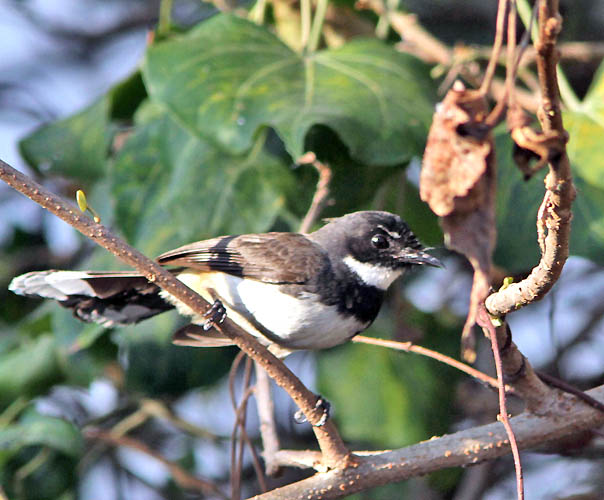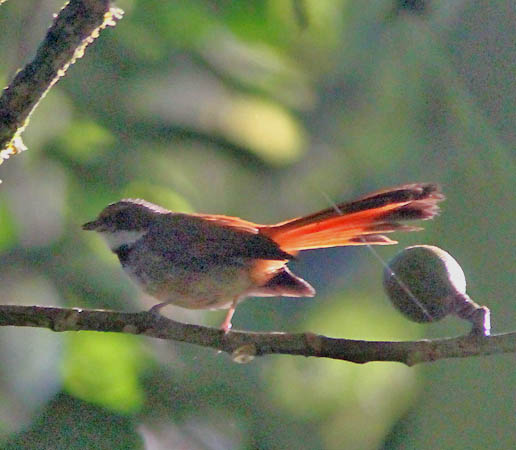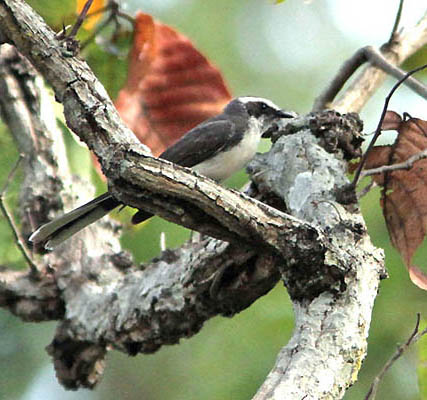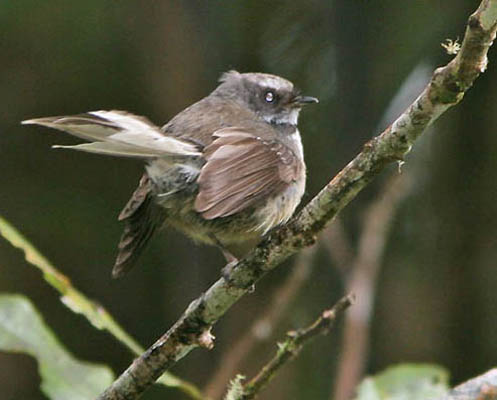| |
FANTAILS Rhipiduridae |
- 48 species worldwide
- DR personal total: 27 species (56%), 7 photo'd
|
 The
Fantails are a homogenous group of distinctive Old World flycatchers
found from India to Australia and many Pacific Ocean islands. The most
familiar in Australia is the misnamed Willie-Wagtail
(above, on a nest welded to a telephone line). It is a familiar garden
and urban park species throughout Australia but also extending to New
Guinea, the Solomons & the Moluccas. In your mind picture this bird
in constant motion, swishing the open tail back and forth in an arc as
it moves. I like this particular shot because it includes the dainty
cup nest so typical of this group. Willie-Wagtail also has a musical
"sweet, pretty creature" song (Simpson & Day 1996) that is
distinctive. Most of this family have characteristic easy-to-whistle or
trilled vocalizations. The
Fantails are a homogenous group of distinctive Old World flycatchers
found from India to Australia and many Pacific Ocean islands. The most
familiar in Australia is the misnamed Willie-Wagtail
(above, on a nest welded to a telephone line). It is a familiar garden
and urban park species throughout Australia but also extending to New
Guinea, the Solomons & the Moluccas. In your mind picture this bird
in constant motion, swishing the open tail back and forth in an arc as
it moves. I like this particular shot because it includes the dainty
cup nest so typical of this group. Willie-Wagtail also has a musical
"sweet, pretty creature" song (Simpson & Day 1996) that is
distinctive. Most of this family have characteristic easy-to-whistle or
trilled vocalizations.
All the fantails are closely related and belong to a single genus: Rhipidura.
Nearly all of them are very active with splayed-open tails swishing as
they work through the mid-canopy or undergrowth. A widespread example
is Malaysian Pied-Fantail of southeast Asia (left), recently split from Philippine Pied-Fantail R. nigritorquis. |
 While
Willie-Wagtail and Pied Fantail may be found in open areas, most of the
family are birds of the dark shadows inside the forest. An example is Rusty-bellied Fantail (right), a Sulawesi endemic. Most fantails are resident — including montane populations of White-throated Fantail (below) in Borneo — but Himalayan populations of this species move downslope in winter. While
Willie-Wagtail and Pied Fantail may be found in open areas, most of the
family are birds of the dark shadows inside the forest. An example is Rusty-bellied Fantail (right), a Sulawesi endemic. Most fantails are resident — including montane populations of White-throated Fantail (below) in Borneo — but Himalayan populations of this species move downslope in winter.

White-browed Fantail
(below left) is a widespread lowland and foothill fantail in India and
parts of southeast Asia. Its typical stance is with the tail lowered.
In contrast, many fantails — including New Zealand Fantail (below right) — typical perch with the tail cocked upwards. |
|
 Gray Fantail
(left) is a very widespread species in open woodlands of Australia, and
with other populations scattered among the islands of Melanesia.
Continued research (often supported by molecular evidence) as elevated
various populations to species level. New Zealand Fantail was split
from Gray Fantail some years back. More recently, various Pacific
populations previously lumped with other widespread fantails have
gained species status. Today, over 20 species of fantails are
restricted to small islands from the Lesser Sundas to the Solomons to
Fiji, Samoa, and Pohnpei. It would be a major accomplishment of
island-hopping travel to see all of the fantails of the world. Gray Fantail
(left) is a very widespread species in open woodlands of Australia, and
with other populations scattered among the islands of Melanesia.
Continued research (often supported by molecular evidence) as elevated
various populations to species level. New Zealand Fantail was split
from Gray Fantail some years back. More recently, various Pacific
populations previously lumped with other widespread fantails have
gained species status. Today, over 20 species of fantails are
restricted to small islands from the Lesser Sundas to the Solomons to
Fiji, Samoa, and Pohnpei. It would be a major accomplishment of
island-hopping travel to see all of the fantails of the world.
Long
ago (1978!) I visited Pohnpei with my father and sister during a
round-the-world summer vacation. We visited waterfalls, cultural
events, and took a walk to the ruins of an ancient civilization. I
still recall passing through the forest on that walk and enjoying
several fantails. I remember these particularly since I was taken with
the tail-twitching behavior.
At the time the fantail on Pohnpei was considered a race of the widespread Rufous Fantail R. rufifrons (e.g., Baker 1951) but now they are split as an endemic species, Pohnpei Fantail R. kubaryi.
In fact, this species was split before we had DNA evidence. Pratt et
al. (1987) wrote: "this form was classified as a subspecies of Rufous
Fantail by Mayr and Moynihan (1946) in a study based entirely on museum
specimens. Although we agree that the two are closely related, our
field observations indicate that they should probably not be considered
conspecific. In addition to the very striking plumage differences, the
two have distinctive vocalizations and foraging behavior." This split
was followed by Sibley & Monroe (1990) and everyone else since
then. I acquired it was an "armchair lifer" when doing research for the
first version of this page back in 2001. |
 The center for fantails in the world is New Guinea. Dale Zimmerman did a fabulous job on this plate (right) published in the Birds of New Guinea
field guide by Beehler et al. (1986). This plate is a wonderful work of
art. I know this because several years back I had the opportunity to
purchase an original plate from Birds of New Guinea, and this is the one I chose. Today the original hangs in my front room, and I look at it every day. The center for fantails in the world is New Guinea. Dale Zimmerman did a fabulous job on this plate (right) published in the Birds of New Guinea
field guide by Beehler et al. (1986). This plate is a wonderful work of
art. I know this because several years back I had the opportunity to
purchase an original plate from Birds of New Guinea, and this is the one I chose. Today the original hangs in my front room, and I look at it every day.
Although
all 12 species of fantail in New Guinea are packed together on one
painting, Dale has captured some some characteristic behaviors. The top
two rows are "forest-flutterers:" they forage at mid-canopy -- often in
flocks of other small birds -- with widespread tails, often dropping in
a fluttery manner like a falling leaf (American observers may be
reminded of the Painted Redstart of the southwest). Left to right these
are:
- Dimorphic Fantail R. brachyrhyncha (dark morph above, gray-tailed morph below);
- right-hand two birds on top row Rufous Fantail R. rufifrons (2 races);
- Chestnut-bellied Fantail R. hyperythra (middle, second row)
- Rufous-backed Fantail R. rufidorsa (right bird, second row).
Then
in the middle come six-and-a-half paintings of undergrowth species.
These birds also have spread tails but tend to work the undergrowth in
a more horizontal posture, often in pairs. The three middle species on
the left side are, top to bottom:
- Black Thicket-Fantail R. maculipectus,
- White-bellied Thicket-Fantail R. leucothorax,
- Sooty Thicket-Fantail R. threnothorax.
I have not seen the Black Thicket-Fantail but my experiences with the
others are that they are very hard to observe without a tape, and that
I taped them up by accident by recording unknown by distinctive songs.
- To the right of these thicket-fantails are the bright rufous female and the all-black male of Black Fantail R. atra,
- below which are the head of a female and the entire body of Black Monarch Monarcha axillaris, which is not a fantail at all but is often confused as one because of its similar behavior.
- The small fantail in the center below the bottom set is the Friendly Fantail R. albolimbata, a tame montane species that wig-wags through mid-canopy and sometimes up high in the canopy.
- At lower left is Northern Fantail R. rufiventris; it perches upright, acts like a typical flycatcher by sallying out after insects, and rare wags its tail.
- At the bottom is Mangrove Fantail R. phasiana that lives in its namesake habitat.
- Finally at lower right is Willie-Wagtail R. leucophrys,
the bird whose photo appears at the top of this page. As you can see it
is a large wagtail, it stands and feeds on the ground, and it is
aggressive. It also follows cattle which is sort-of cool for a
passerine.
|
| |
Photos: The nest-sitting Willie Wagtail Rhipidura leucophrys was on Halmahera I., Indonesia, on 7 Oct 2011. The Malaysian Pied-Fantail R. javanica was at the Muang Boran fish ponds near Bangkok, Thailand, on 31 Dec 2012. The Rusty-bellied Fantail R. teysmanni was at Gunung Ambang NR, Sulawesi, Indonesia, on 5 Oct 2011. The White-throated Fantail R. albicollis was on Mt. Kinabalu, Borneo, Malaysia, in Aug 1988. The White-browed Fantail R. aureola was at Sab Sadao, Thap Lan NP, Thailand, on 27 Dec 2012. The New Zealand Fantail R. fuliginosa was at Manginanga, North Is., New Zealand, on 15 Nov 2009. The Gray Fantail R. albiscapa was on Gulpa I., New South Wales, Australia, 31 Dec 1997. Dale Zimmerman painted the Fantail plate from Birds of New Guinea, 1st ed. (Beehler et al. 1996).
Photos © Don Roberson; all rights reserved.
Bibliographic note: There is no "family book" per se, but a fine introduction to this family, with excellent photos, is in Boles (2006).
Literature cited:
Andersen,
M.J., P.A. Hosner, C.E. Filardi, and R.G. Moyle. 2015. Phylogeny of the
monarch flycatchers reveals extensive paraphyly and novel relationships
within a major Australo-Pacific radiation. Molec. Phylog. Evol. 83:
118-136.
Baker, R. H. 1951. The Avifauna of Micronesia, its Origin, Evolution, and Distribution. Univ. of Kansas publ. 3: 1-359.
Beehler,
B. M., T. K. Pratt, and D. A. Zimmerman. 1986. Birds of New Guinea.
Princeton Univ. Press, Princeton, N. J. Clements, J. F. 1991. Birds of
the World: A Checklist. 4th ed. Ibis Publ., Vista, CA.
Boles, W.E. 2006. Family Rhipiduridae (Fantails), pp. 200–243 in
Handbook of the Birds of the World (del Hoyo, J., A. Elliott & D.A.
Christie, eds). Vol. 11. Lynx Edicions, Barcelona, Spain.
Coates,
B. J. 1990. The Birds of Papua New Guinea. Part II. Dove Publ., Ltd.,
Alderley, Australia. Mayr, E., and Moynihan, M. 1946. Evolution in the
Rhipidura rufifrons group. American Mus. Novit. 1144: 1-11.
Sibley,
C.G., and J.E. Ahlquist. 1990. Phylogeny and Classification of Birds: a
Study of Molecular Evolution. Yale Univ. Press, New Haven, CT.
Simpson,
K, and N. Day. 1996. A Field Guide to the Birds of Australia, revised
5th ed. Penguin Books Australia Ltd., Ringwood, Victoria, Australia.
|
| |
|
|


 The
Fantails are a homogenous group of distinctive Old World flycatchers
found from India to Australia and many Pacific Ocean islands. The most
familiar in Australia is the misnamed Willie-Wagtail
(above, on a nest welded to a telephone line). It is a familiar garden
and urban park species throughout Australia but also extending to New
Guinea, the Solomons & the Moluccas. In your mind picture this bird
in constant motion, swishing the open tail back and forth in an arc as
it moves. I like this particular shot because it includes the dainty
cup nest so typical of this group. Willie-Wagtail also has a musical
"sweet, pretty creature" song (Simpson & Day 1996) that is
distinctive. Most of this family have characteristic easy-to-whistle or
trilled vocalizations.
The
Fantails are a homogenous group of distinctive Old World flycatchers
found from India to Australia and many Pacific Ocean islands. The most
familiar in Australia is the misnamed Willie-Wagtail
(above, on a nest welded to a telephone line). It is a familiar garden
and urban park species throughout Australia but also extending to New
Guinea, the Solomons & the Moluccas. In your mind picture this bird
in constant motion, swishing the open tail back and forth in an arc as
it moves. I like this particular shot because it includes the dainty
cup nest so typical of this group. Willie-Wagtail also has a musical
"sweet, pretty creature" song (Simpson & Day 1996) that is
distinctive. Most of this family have characteristic easy-to-whistle or
trilled vocalizations.  While
Willie-Wagtail and Pied Fantail may be found in open areas, most of the
family are birds of the dark shadows inside the forest. An example is Rusty-bellied Fantail (right), a Sulawesi endemic. Most fantails are resident — including montane populations of White-throated Fantail (below) in Borneo — but Himalayan populations of this species move downslope in winter.
While
Willie-Wagtail and Pied Fantail may be found in open areas, most of the
family are birds of the dark shadows inside the forest. An example is Rusty-bellied Fantail (right), a Sulawesi endemic. Most fantails are resident — including montane populations of White-throated Fantail (below) in Borneo — but Himalayan populations of this species move downslope in winter.


 Gray Fantail
(left) is a very widespread species in open woodlands of Australia, and
with other populations scattered among the islands of Melanesia.
Continued research (often supported by molecular evidence) as elevated
various populations to species level. New Zealand Fantail was split
from Gray Fantail some years back. More recently, various Pacific
populations previously lumped with other widespread fantails have
gained species status. Today, over 20 species of fantails are
restricted to small islands from the Lesser Sundas to the Solomons to
Fiji, Samoa, and Pohnpei. It would be a major accomplishment of
island-hopping travel to see all of the fantails of the world.
Gray Fantail
(left) is a very widespread species in open woodlands of Australia, and
with other populations scattered among the islands of Melanesia.
Continued research (often supported by molecular evidence) as elevated
various populations to species level. New Zealand Fantail was split
from Gray Fantail some years back. More recently, various Pacific
populations previously lumped with other widespread fantails have
gained species status. Today, over 20 species of fantails are
restricted to small islands from the Lesser Sundas to the Solomons to
Fiji, Samoa, and Pohnpei. It would be a major accomplishment of
island-hopping travel to see all of the fantails of the world.  The center for fantails in the world is New Guinea. Dale Zimmerman did a fabulous job on this plate (right) published in the Birds of New Guinea
field guide by Beehler et al. (1986). This plate is a wonderful work of
art. I know this because several years back I had the opportunity to
purchase an original plate from Birds of New Guinea, and this is the one I chose. Today the original hangs in my front room, and I look at it every day.
The center for fantails in the world is New Guinea. Dale Zimmerman did a fabulous job on this plate (right) published in the Birds of New Guinea
field guide by Beehler et al. (1986). This plate is a wonderful work of
art. I know this because several years back I had the opportunity to
purchase an original plate from Birds of New Guinea, and this is the one I chose. Today the original hangs in my front room, and I look at it every day.